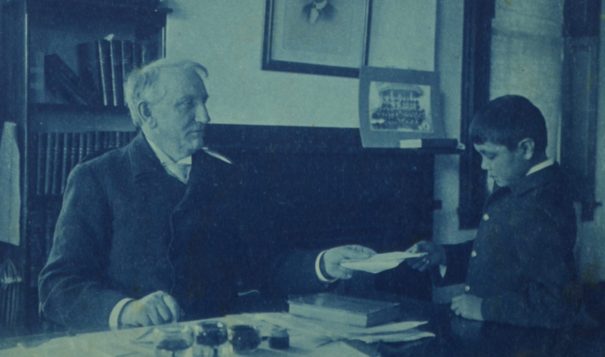 U.S. Army general Richard Henry Pratt is seen here with an Indian boarding school student, circa 1880. Pratt was the founder of the Carlisle Indian Industrial School and advocated
the Kill the Indian -- Save the Man approach to the education of Indian children. Photo: U.S. Military Institute, U.S. Army Heritage and Education Center, Carlisle, Pennsylvania
U.S. Army general Richard Henry Pratt is seen here with an Indian boarding school student, circa 1880. Pratt was the founder of the Carlisle Indian Industrial School and advocated
the Kill the Indian -- Save the Man approach to the education of Indian children. Photo: U.S. Military Institute, U.S. Army Heritage and Education Center, Carlisle, Pennsylvania
BY TIM GIAGO
Native Sun News
Down on the immigrant camps along the Mexican
The doctors described their symptoms as extreme loneliness, fear, and uncertainty. The younger ones, children 5 and 6 years old, suffered from an inability to stop crying, day and night. It struck me immediately that I had seen these same symptoms in children many years ago at the boarding schools. In fact, I probably experienced these symptoms myself. I vividly recall those first few nights in the dormitories at the boarding schools.
Late into the night, one could hear the smaller children sobbing in their beds. Begging for the moms and dads in the Lakota language. I know that I, along with many of my schoolmates, cried ourselves to sleep during those first few days at the boarding school. Loneliness and loss have a way of overcoming the tough-guy images most of us wanted to project. Many of us arrived at the boarding schools when we were only five or six years old.
The only homes we ever knew were
Over the years I have written about the historical trauma experienced by Native Americans. Oglala Sioux Tribal Attorney Mario Gonzalez has written about the historical fear that has haunted Native Americans for so many years especially when they were pushed from their ancestral lands and on to lands foreign to themselves by the U. S. Government in its grab for more land.
The Indian children and their parents never knew what would happen to them next as they were herded on to reservations far from the lands their ancestors had lived on for time immemorial. Sometimes the small camps the Indian families had set up while trying to find their way forward were wiped out simply because they were in the way. The entire populations of the camps were slaughtered.
Late into the night, one could hear the smaller children sobbing in their beds. Begging for the moms and dads in the Lakota language. I know that I, along with many of my schoolmates, cried ourselves to sleep during those first few days at the boarding school.
Tim Giago
The federal government, in its infinite wisdom, determined that the only way to civilize the indigenous population was to “Kill the Indian; save the man.” Kill the Indian was supposed to be the figurative expression of neutralizing the Indian in the children and replacing that death with a human being more like themselves.
Anyone can travel to any former Indian boarding school in America and see the graveyards containing the bodies of Indian children whose deaths were more than figurative. The same can be said of the indigenous populations of South and Central America. And the boarding schools in America had nothing on the horrific Indian boarding schools, euphemistically called residential schools, established in Canada for the same reasons.
First of all the students had to be exorcised of their language, religion, culture
What continuing impact did the boarding school experience have on the young adults when they came out of the schools and moved back to the communities their teachers had impressed upon them as antiquated, backward, and out of step with civilization? Did the PTSD condition associated with the brainwashing cause many of them to turn to alcohol and drugs in an effort to lessen the impact of that affliction?
We do know that the historic trauma inflicted upon the indigenous populations of the Western Hemisphere over the centuries caused damage and thanks to the many Native professionals now working with their own people, these historic traumas are being addressed. For many, it was too late, but we see a clear path to a better future. We should also determine how much of the historic PTSD that afflicted the grandparents and parents of today’s children
Too many people, especially non-Natives say, “Get over it.” If only it was that simple. One does not take centuries of trauma and get rid of it overnight.
Contact Tim Giago at najournalist1@gmail.com
